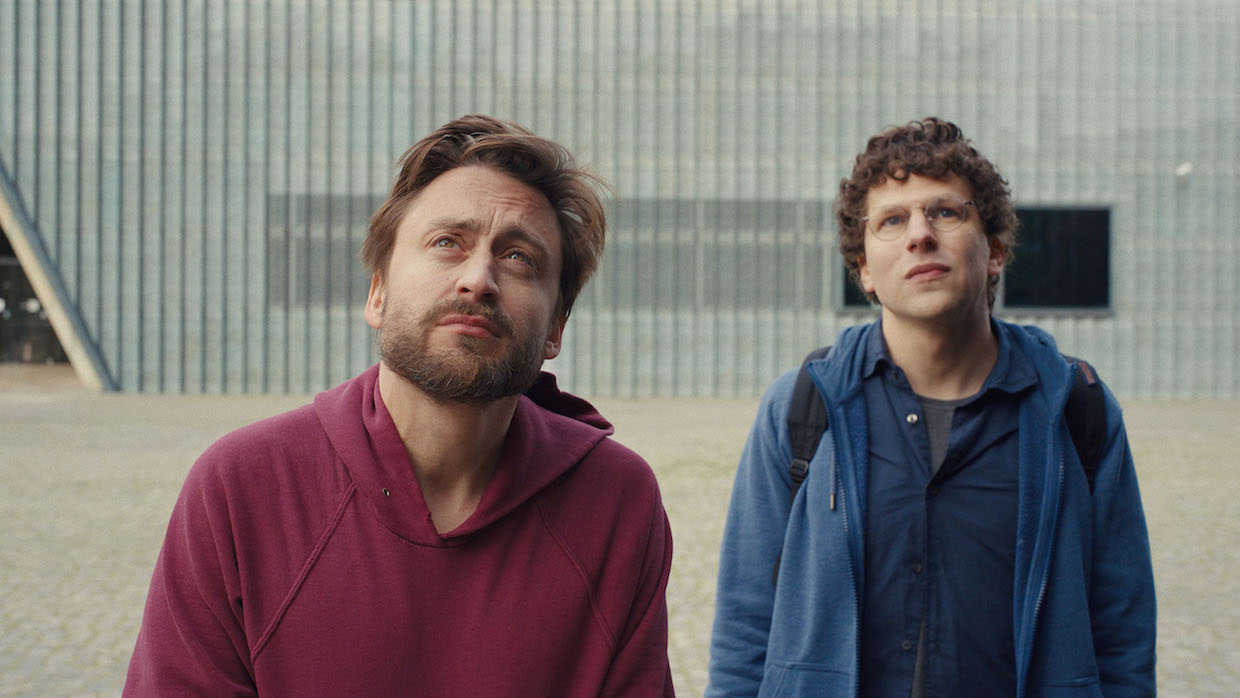 Back to selection
Back to selection
“My Main Idea Was To Work With Perspective”: DP Michał Dymek on A Real Pain
 A Real Pain, courtesy of Sundance Institute.
A Real Pain, courtesy of Sundance Institute. Jesse Eisenberg returns to Sundance with A Real Pain, the actor’s second directorial effort following his 2021 debut When You Finish Saving the World. Eisenberg acts alongside Succession sensation Kieran Culkin, embodying cousins who travel to Poland in order to honor the legacy of their deceased grandmother.
Below, cinematographer Michał Dymek describes how he was brought on board the project, the influences he and Eisenberg referenced and the emotional weight of shooting at the Majdanek Concentration Camp.
See all responses to our annual Sundance cinematographer interviews here.
Filmmaker: How and why did you wind up being the cinematographer of your film? What were the factors and attributes that led to your being hired for this job?
Dymek: I was invited to a casting where I had the opportunity to have some nice conversations with Jesse Eisenberg. Jesse and I quickly got into a flow, talking about the directions this film should take visually. I also remember that Jesse really liked my work on the previous film Sweat, which certainly influenced me to be on board.
Filmmaker: What were your artistic goals on this film, and how did you realize them? How did you want your cinematography to enhance the film’s storytelling and treatment of its characters?
Dymek: My main idea was to work with perspective. The film is about characters who see themselves differently. Each of their observations complements the other. Their attitudes look different depending on whose perspective we look at the hero through. I wanted to combine using standard lenses with longer optics, whose characteristic is to flatten the perspective to play with the fact that sometimes the same image can be defined differently by choosing a different focal lens.
This is a film in which the most important thing was to focus on the actors’ performance. I had to think in a flexible way and be prepared for various eventualities resulting from the scenes changing frequently as a result of the development of the scene between the actors. It also involved working with two cameras and being the operator of one of them, which required a lot of concentration to film everything properly.
Filmmaker: Were there any specific influences on your cinematography, whether they be other films, or visual art, or photography, or something else?
Dymek: The main inspiration and reference was the script and location we selected during location scouting. In conversations during prep, Jesse mentioned a lot about the poetics of storytelling with long shots from Woody Allen’s films. It was a great direction because it matched the temperature of the text very well, and I personally really like the simplicity of long shots that can powerfully capture a scene more than once in one shot.
Another inspiration came from archival photos of the Majdanek camp and historical records of the old Jewish part of Lublin that no longer exists. The historical record was an inspiration for us to photograph places in Lublin that no longer exist but carry a beautiful memory of Jewish history.
Filmmaker: What were the biggest challenges posed by production to those goals?
Dymek: I think that shooting the scenes on the train where, apart from quite a large number of shots in a tight time, we had to make sure that the train, which was parked on the platform, was going through Poland. This involved a large build of green screens behind the windows on both sides of the train, which required dynamic lighting system imitating the movement of the train.
Additionally, with only two decorated train interiors at our disposal, we had to create the illusion of walking through 8 carriages by photographing them in different ways and cleverly changing the set design and the arrangement of extras.
Filmmaker: What camera did you shoot on? Why did you choose the camera that you did? What lenses did you use?
Dymek: We used Arri MIni LF and Leitz M 0.8. I choose this camera because I I love its ergonomics and the work flow of this camera, which allows me to work with my own LUTs that I created together with colorist Marcy Robinson. Moreover, I am a fan of the field of view of the large format and how it defines the space of close-ups and wide planes.
Filmmaker: Describe your approach to lighting.
Dymek: We treated light in super simple way—mainly as an extension what we found interesting and inspiring in our location where we shoot. We tried to create as much as natural lighting which on the other hand also had something cinematic.
Filmmaker: What was the most difficult scene to realize and why? And how did you do it?
Dymek: It was a shooting day at the Majdanek Concentration Camp in Lublin. Being in a place burdened with such an unimaginably tragic history was a very difficult experience. The scenes played, resonating with the place of testimony of the Holocaust and genocide of the Polish population, made this day of shooting very hard to endure for everyone.
Filmmaker: Finally, describe the finishing of the film. How much of your look was “baked in” versus realized in the DI?
Dymek: Final film look is pretty close to offline grade where we used beautiful LUT’s prepared by the amazing Marcy Robinson from Nice Shoes. On the end we added more warmth in order to give it an even more nostalgic look fitting the return of our main protagonist to their hometown.
TECH BOX
Film Title: A Real Pain
Camera: Alexa Mini LF
Lenses: Leitz M 0.8
Lighting: Arri Skypanels (360,60,120), M9, M4, Aperture, Aster Tubes
Processing: Arriraw
Color Grading: 4K DCP DA VINCI with MARCY ROBISONS
